Wildlife
The nutrient rich conditions of Lake Lemon provide an ideal habitat for many aquatic vegetation species. In order to prevent aquatic vegetation from hindering access to docks and boating ways, multiple seasonal treatments are necessary. Lake Lemon is currently managing five main species of aquatic vegetation through herbicide treatment.
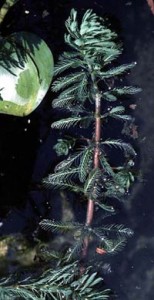 Eurasian watermilfoil, left, (Myriophyllum spicatum): Eurasian watermilfoil is a perennial, aquatic, submersed plant native to Eurasia and Africa. E. milfoil will out compete native plants and dominate the waters of lakes and reservoirs. The preferred habitat of E. milfoil is brackish waters of ponds, lakes, reservoirs, and slow streams. The plant can grow to heights of 3-9 feet.
Eurasian watermilfoil, left, (Myriophyllum spicatum): Eurasian watermilfoil is a perennial, aquatic, submersed plant native to Eurasia and Africa. E. milfoil will out compete native plants and dominate the waters of lakes and reservoirs. The preferred habitat of E. milfoil is brackish waters of ponds, lakes, reservoirs, and slow streams. The plant can grow to heights of 3-9 feet.
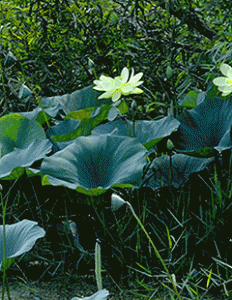 American Lotus, right, (Nelumbo lutea): American Lotus is a perennial, aquatic, floating-leaved and/or emergent plant. Lotus is native to the U.S. The preferred habitat of this plant is muddy shallow waters such as lake margins. The plant can grow to heights of 1-4 feet. Upon reaching the surface of the water, American Lotus may remain as a floating-leaved plant or extend out of the water as an emergent plant. American Lotus can form large mats of dense vegetation that restrict a variety of recreational activities.
American Lotus, right, (Nelumbo lutea): American Lotus is a perennial, aquatic, floating-leaved and/or emergent plant. Lotus is native to the U.S. The preferred habitat of this plant is muddy shallow waters such as lake margins. The plant can grow to heights of 1-4 feet. Upon reaching the surface of the water, American Lotus may remain as a floating-leaved plant or extend out of the water as an emergent plant. American Lotus can form large mats of dense vegetation that restrict a variety of recreational activities.
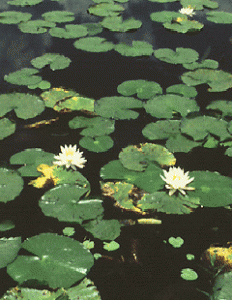 Spatterdock, left, (Nuphar lutea): Spatterdock is a rooted, floating-leafed plant similar to true water lilies. Leaves can be submersed, floating, or emergent above the water’s surface. The leaves are heart-shaped and slightly longer than they are wide. Spatterdock can reproduce by seed germination and by underground rhizomes. The plant is can also be known as Yellow Cow-lily.
Spatterdock, left, (Nuphar lutea): Spatterdock is a rooted, floating-leafed plant similar to true water lilies. Leaves can be submersed, floating, or emergent above the water’s surface. The leaves are heart-shaped and slightly longer than they are wide. Spatterdock can reproduce by seed germination and by underground rhizomes. The plant is can also be known as Yellow Cow-lily.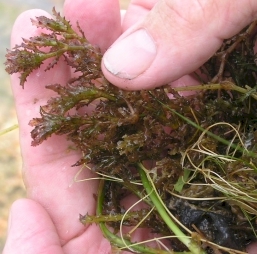
- Brittle Naiad, right, (Najas minor): Brittle naiad or marine naiad occurs in fresh or brackish waters. It is a rooted submerged annual plant that resembles southern naiad except the leaves are highly toothed (3 – 12 teeth). Leaves are up to 1 1/4 inch long and 3/16 wide with several leaves at each node. Flowers (1/8 to 3/16 inch long) are found during summer, in the leaf axis.

- Purple Loosestrife, left, (Lythrum silicaria): Purple loosestrife is a herbaceous emergent, perennial, recognized by long spikes of purple flowers. It can be found in wet meadows, shores, and in disturbed natural wetland areas. Purple loosestrife is an exotic species to this area. Each plant averages 4 feet in height and flowers between June and September. Each flower stalk can produce up to 100,000 seeds. Please contact the LLCD office immediately if any purple loosestrife is spotted around Lake Lemon.
The following links show the proposed treatment areas for the current year and actual treatments from past years.
2016 Summary and Maps (pdf)
2015 Summary and Maps (pdf)
2014 Summary and Maps (pdf)
2013 Summary and Maps (pdf)
2012 Treatments (JPEG) June 11, July 2, July 31, August 15, Lotus Map
2011 Treatments (JPEG) July 22 (emergent), July 22 (submersed),
2010 Treatments (JPEG) May 24, June 17, July 22, August 5
2009 Treatments (JPEG) July 28, July 28, August 20
2008 Treatments (JPEG) June 25, June 25, August 13, September 16
2007 Treatments (JPEG) May 23, June 8, July 13, August 2
The Indiana Department of Natural Resources started the Indiana Nongame and Endangered Wildlife Program in 1985. Over a period of five years, 73 bald eagle chicks were released at Monroe Reservoir in Monroe County.
The bald eagle is protected under several state and federal laws, including the Migratory Bird Treaty Act and the Bald Eagle Protection Act. Just recently, the bald eagle was downgraded in status from federal endangered to federal threatened. As a federally listed species, it is protected under the Endangered Species Act. The bald eagle is also a n Indiana endangered species, giving it state protection as well.
Beavers (Castor canadensis): Semi-aquatic animal that are common inhabitants of lakes and streams throughout North America. Beavers typically have thick fur, flattened tail, and prominent front teeth. Adult weight ranges from 12 to 40 pounds.
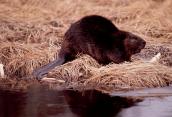 Possible Problems: Beaver dams can significantly change the surrounding area by reducing streamflow and causing upstream flooding. Tree removal is also a concern for landowners and lake managers. Beavers remove trees for food and damage trees when gnawing to wear down their teeth. Removal of streamside trees is a particular concern due to the stream bank stabilization trees provide.
Possible Problems: Beaver dams can significantly change the surrounding area by reducing streamflow and causing upstream flooding. Tree removal is also a concern for landowners and lake managers. Beavers remove trees for food and damage trees when gnawing to wear down their teeth. Removal of streamside trees is a particular concern due to the stream bank stabilization trees provide.
Possible Solutions: Small gauge wire mesh (less than one inch) or heavy guage hardware cloth can be effective in deterring beavers from gnawing on individual trees. The material should be secured on the tree up to a height of three feet. Larger stands of trees can be fenced to deter beaver damage. The fence should be at least three feet high and constructed of a material that will not allow beavers to crawl under or through the fence. Chemical repellents are commercially available that can be applied to trees to prevent beaver activity, but should be reapplied periodically.
Please contact the Lake Lemon Office if interested in trapping beavers.
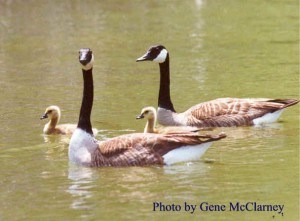 Giant Canada Goose (Branta canadensis): Commonly found in water bodies across North America and are considered the most widespread goose in North America. Canada geese are easily identified by their brown bodies with white rumps, black necks and heads, and white patch on the side of their face. The Giant geese can range from 25 to 43 inches tall, 24 pounds, and can have wingspan up to 6 feet.
Giant Canada Goose (Branta canadensis): Commonly found in water bodies across North America and are considered the most widespread goose in North America. Canada geese are easily identified by their brown bodies with white rumps, black necks and heads, and white patch on the side of their face. The Giant geese can range from 25 to 43 inches tall, 24 pounds, and can have wingspan up to 6 feet.
Possible Problems: Geese can become a nuisance to landowners because they congregate in large groups; are noisy; leave droppings on yards, docks, and beaches; eat ornamental plants; and can become aggressive when nesting or raising young. Canada geese can also damage native plant communities. Large numbers of geese can overgraze shoots preventing their establishment on shorelines and in shallow waters. This can decrease habitat for fish and other wildlife and can increase shoreline erosion.
Possible Solutions: Landowners can take many steps to discourage Canada geese from congregating on their property. Do not feed any geese or other waterfowl or leave food where it is easily accessible to geese. Planting shrubs, native grasses, wild flowers, or trees close to the shoreline can cause geese to avoid the area. An S-shaped path through a buffer strip allows for access to the water but deters the geese from following the path. Some landowners have successfully deterred geese from their property by constructing a fence with a wire or monofilament line about six inches from the ground. Flags, streamers, etc. may scare geese away from docks and shorelines, but the decoys must be moved frequently to be effective.
Canada geese are a federally protected species of waterfowl; it is important that landowners do not harm Canada geese or disturb the nests or nesting areas.
(The Lake Lemon Conservancy District annually requests permission from the IDNR, Fish and Wildlife Division to treat resident Canada goose nests and eggs. In 2007, IDNR no longer required a permit to treat resident Canada goose nests, but one must register; perform treatments prior to June; and report how many nests treated. On April 22nd, 2010, the LLCD treated a total of 203 eggs from 18 nests on Cemetery Island.
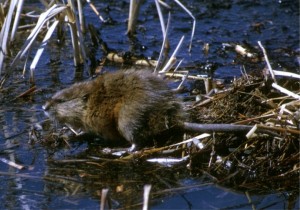 Muskrat (Ondatra zibethica): Semi-aquatic rodent that commonly inhabits lakes and streams in the Midwest. Adult muskrats can grow from 18 to 25 inches long and weigh about 2. 5 pounds. They can swim up to three miles per hour and can remain submerged for 15 minutes.
Muskrat (Ondatra zibethica): Semi-aquatic rodent that commonly inhabits lakes and streams in the Midwest. Adult muskrats can grow from 18 to 25 inches long and weigh about 2. 5 pounds. They can swim up to three miles per hour and can remain submerged for 15 minutes.
Possible Problems: Muskrats dig dens by burrowing into banks with their sharp front claws. They prefer to build dens in shoreline areas with steep slopes (greater than 3:1) and back heights of three feet or greater. This practice can cause shoreline destabilization. The burrows can increase erosion and eventually lead to shoreline collapse. Muskrats have also been known to chew (eat) through the rubber bellows on moored boats. Causing them to sink.
Possible Solutions: Making alterations to the slope or composition of the shoreline can reduce shoreline damage. Designing shorelines with more gentle slopes (less than 3:1) will discourage muskrat occupation and prevent excessive shoreline erosion. Rip-rapping can also prevent muskrat burrowing and reduce soil erosion. To be effective, rip-rap should be installed at least six inches thick and extend at least one foot above and three feet below the water level.
Invasive Species
Zebra Mussel, ID and Prevention
Zebra Mussel (Dreissena polymorpha

The infestation of zebra mussels are a significant problem in the Midwest. They are not native to the United States and can spread rapidly from one lake to another. Zebra Mussel presence has recently been discovered at Geist Reservoir, Indianapolis. This is the first occurrence of Zebra Mussels in central Indiana waters. If you have recently been boating in Geist Reservoir or any other body of water, please take due diligence in inspecting your hull, prop and all boat surfaces for Zebra Mussels prior to launching into Lake Lemon.
The primary mode of transport for zebra mussels is boats that travel from one water body to another. Prior to leaving bodies of water, running boats at high speeds will dislodge new Zebra Mussels. The most effective way to keep boats from transporting zebra mussels is to remove all vegetation from the prop and trailer, completely drain the boat, and let it dry for at least 5 days before transporting it to another water body. If Zebra Mussels are found attached to your hull, use a putty knife to dislodge them. If scheduling does not allow for drying the boat 5 days, washing the boat, motor, and trailer with hot water (at least 104 degrees) or using a high pressure hose can be an effective method of removing adult and juvenile zebra mussels. Zebra Mussels can be flushed from engines by clamping a garden hose motor flusher to the engine and running engine for about ten minutes. Boat owners are also encouraged to disinfect live wells and bilges with chlorine bleach solution (one part chlorine to ten parts water).
Anglers should dispose of excess bait on land and should not transfer fish or other aquatic organisms between water bodies.
At this time, zebra mussels have not been observed at Lake Lemon. But, due to the location and popularity of the lake, it is a likely target for zebra mussel infestation. Once established, Zebra Mussels compete with juvenile fish for planktonic and algal food sources. They also cause major problems by attaching to any surface and clogging pipes and inlets. The Lake Lemon Conservancy District thanks you for your effort in maintaining a Zebra Mussel free Lake Lemon.
A good video on preventing the spread of Zebra Mussels can be found by following the link below,
Our Address & Map
- office@lakelemon.org
- TEL: (812) 334-0233
- FAX: (812) 335-0038
- 7599 North Tunnel Road, Unionville, IN 47468
Latest News
-
2024 August Cruise-In
Lake Lemon is rolling out its first-ever Cruise-In event next month on Saturday […]
-
July 20th 2024, Board Meeting
The next regularly scheduled LLCD board meeting, and first public budget discussion, will take […]
-
The Beach Opens at Riddle Point
Summer has crept in fast this year, are you ready to kick it […]
-
2024 Fireworks Show!
Mark your calendars! The 31st annual Lake Lemon Riddle Point Park fireworks show […]
-
2024 Eclipse Recap
Reflecting on the Eclipse one week later and I am still in awe […]


